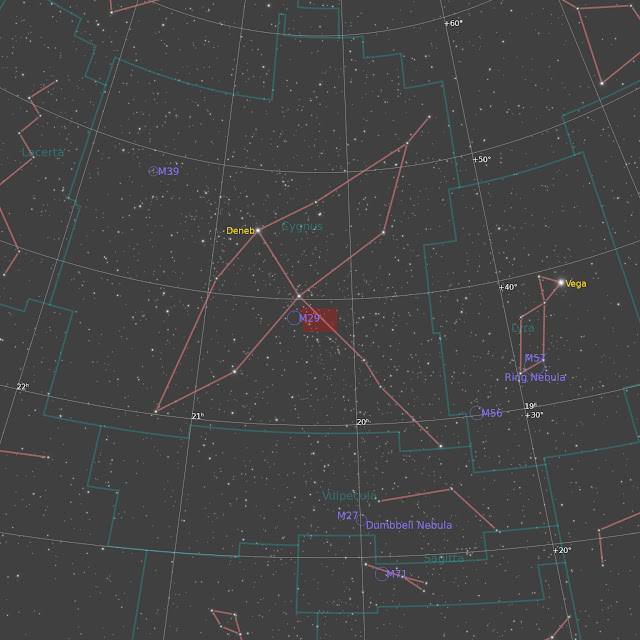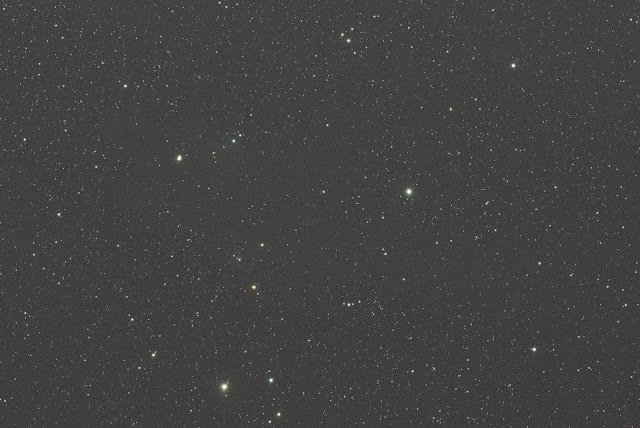First off, it's been a while ...
The last clear night that I was able to image was on October 3rd. So, apologies for taking so long between posts. The weather has been horrendous and travel for work forced me to miss the one clear night we had in November. I was super excited to see a clear forecast for Thursday night (December 14th). Our astronomy club has an imaging group, we're called the Tuesday Night Imagers. the leader of our group posted on the forum of our website that Tuesday would be Thursday this week. One advantage of winter is I can make it out to the observatory after work and get a few hours of imaging in and still get home at a reasonable time.
We made our plans ahead of time. The plan was to try my personal camera, the ZWO ASI2600MC-Pro on the club's Celestron 14" Edge D Telescope. Our club has the 14" and a Tele Vue NP-101is mounted on an Astro Physics AP-1200 mount. We have an Atik 383L+ Color camera for the 14". A great camera, but it is an older CCD camera and is starting to show it's age. We are actively discussing what camera to get to replace it. We wish to stick with a One-Shot Color (OSC) camera for simplicity and convivence. Technically, my camera is a great match for the NP-101is but not for the 14". Even with the 0.7x focal reducer, the 14" has focal length of 2,738 mm. Therefore, my camera's small pixels result in a very over-sampled image scale with the 14". This is typically not desirable. However, we have seen some great results from similar setups and decided to give this a try.
I got to the observatory around 5:30 pm. The observatory director, the leader of our imaging group, was unable to make it out to the observatory due to a last minute issue. Typically, the observatory director and another member of our group are the main operators of the telescope. The other telescope operator and I got the telescopes going. My camera on the 14" and the other telescope operator put his ZWO ASI1600MC-Pro on the NP-101. The observatory director and a couple of other members of our imaging group joined us via Zoom.
The skies were not great. lots of high/thin clouds or haze especially towards the western horizon. Of course, that's exactly where we wanted to image. We wanted to get data on Comet 12/P Pons-Brooks which is near the bright star Vega. We tried for about an hour, but the data was not looking good. Autofocus was struggling and there was little signal from the comet. I have not tried to process the data from the 14" yet but the other telescope operator managed to get a nice image (especially considering the conditions).
As it was also the peak of the Geminids meteor shower, we did try to get outside and see if we could see meteors. We saw about four or five. We also noticed skies were better towards the Southeast, where the constellation Orion was rising. We decided to give up on the comet and slew to the Horsehead Nebula (Barnard 33). We slewed to B33 and got both telescopes framed as best as we could. We were feeling the pressure to get imaging quickly, so we didn't rotate the camera or refine (manually) the relative pointing of the telescopes to one another, a disadvantage of two scopes on one mount. We dialed in our exposure settings, 120 sec subs at Gain 100 with an Offset of 50 for me and started collecting exposures. The results looked really good. The stars were nice and round. We imaged for little over an hour. It was a work night, skies weren't the best, and both of us had a pretty good drive home. This is the resulting image from the night's work. Pretty encouraging results!
 |
| The Horsehead Nebula (B33) from the BAA's Beaver Meadow Observatory on 12/14/2023. |
Processing
There was a lot of conversation in our club's forum leading up to Thursday night and again afterwards regarding how to capture and process images with this scope/camera combination. We are lucky to have some talented imagers in the group, one in particular who is both very talented and technically knowledgeable. This person was a key participant in those discussions and I'm personally very grateful for his mentoring.
All pre and post processing was performed in PixInsight. Pre-processing: All 34 images were examined in Blink, 2 were rejected. The remaining 32 images were calibrated, registered, and stacked in WBPP with 1X Drizzle integration, astrometric solution, and auto-crop enabled.
Linear Post-processing: Gradient was removed with the GraXpert script (AI mode), initial deconvolution with BlurXT in Correct Only mode, color calibration SPCC, second deconvolution with BlurXT, noise reduction NoiseXT, and the image was made non-linear with HT. Non-linear Post processing: Stars were removed with StarXT. Stars: Saturation curve applied with CT and green noise removed with SCNR. Starless: Multiple iterations of CT were applied to increase brightness and contrast, Saturation was added with CT, green noise was removed with SCNR, and noise reduction was further reduced with NoiseXT. The image was sharpened with LHE at 3 different kernel sizes and MMT. Dark structure was enhanced with the DSE script and stars were screened back in with Pixel Math. No down sampling was performed.
What is it?
The Horsehead Nebula (Barnard 33) is a small dark nebula silhouetted against the emission nebula IC434. B33 resembles the profile of the head of a horse. It is a concentration of dust and non-luminous gas that blocks light of the nebula behind it.
 |
| Annotated image of the Horsehead Nebula |
How big is it?
This object has an angular distance of 6.0 x 4.0 arcminutes on the night sky. The object is 2.8 light-years (ly) across.
How far is it?
It is located about 1,600 light-years (ly) from Earth in the Constellation of Orion.
How to find it?
It is located close to Alnitak, one of the 3 belt stars in Orion. This makes it easy to find. However, it is much easier to photograph than visually observe. To give you the best chance of success in visually observing it, use a large aperture telescope, use an H-beta nebula filter, and get to dark skies. It is tiny and it is essentially like trying to find a black fingerprint on a black tablecloth. Try to find the emission nebula IC 434 and look for the absence of the nebula. Photographically, this target shows up relatively easily and can be captured with and without the use of filters.
 |
| Finder Chart for B33 |
Image Details:
Capture Date: 12/14/2023
Location: North Java, NY (BAA's Beaver Meadow Observatory
Telescope: Celestron 14" Edge HD w/0.7x Focal Reducer
Camera: ZWO ASI2600MC Pro
Filter: N/A
Mount: Astro Physics AP-1200
Exposure: 32 exposures at 120 sec / Gain 100 / Offset 50 / -10°C each for a total exposure of 1 hour and 4 minutes.
Software: NINA, PHD2, and PixInsight
Clear Skies!
Ernie























